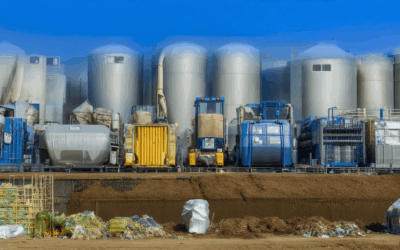Carbon capture agriculture is emerging as a transformative approach to address climate change and enhance agricultural sustainability. By integrating innovative practices, farmers can play a pivotal role in reducing greenhouse gas emissions while improving soil health and crop productivity. This article delves into the essential aspects of carbon capture agriculture, offering comprehensive answers to top farmer FAQs. From understanding what carbon capture entails to exploring the best crops for sequestration and the methods to maximize carbon storage, this guide provides actionable insights. Discover how farmers can harness the power of carbon farming to contribute to global climate solutions, navigate government incentives, and unlock market opportunities. Whether you’re new to the concept or looking to enhance your farming operations, this article serves as a valuable resource to empower farmers in the transition to sustainable, carbon-smart agriculture.

What is Carbon Capture in Agriculture?
Carbon capture in agriculture refers to the process of reducing atmospheric greenhouse gas emissions, particularly CO2, through agricultural practices that enhance carbon sequestration and storage. This includes techniques that optimize soil health, promote biodiversity, and reduce emissions associated with farming operations.
Key Concepts
Carbon capture in agriculture is often synonymous with carbon farming and regenerative agriculture. These practices focus on sustainable land management to increase carbon uptake and storage in ecosystems. By implementing practices that enhance carbon retention, farmers can play a vital role in mitigating climate change.
Methods
Several methods contribute to carbon capture in agriculture:
- Cover Cropping: Planting cover crops like clover or wheat to protect soil, reduce erosion, and sequester carbon.
- Agroforestry: Integrating trees and shrubs into farming systems to improve soil fertility and capture carbon.
- Reduced Tillage: Minimizing plowing to conserve soil and reduce carbon emissions associated with machinery use.
- Organic Farming: Using organic inputs to enhance soil health and reduce reliance on synthetic fertilizers, which can release nitrous oxide—a potent greenhouse gas.
- Perennial Crops: Planting long-lived plants like fruit trees and grasses to increase carbon sequestration over time.
Benefits
Adopting carbon-capturing practices in agriculture offers numerous benefits, including:
- Improved Soil Health: Stronger root systems and better nutrient retention lead to healthier soils capable of storing more carbon.
- Carbon Sequestration Rates: Some practices can sequester up to several tons of carbon per acre annually, contributing to global carbon goals.
- Biodiversity Enhancement: Diverse ecosystems support more species and contribute to overall ecosystem resilience.
- Climate Resilience: Healthy soils are better equipped to withstand droughts, floods, and extreme weather events.
Challenges
While carbon capture in agriculture is a promising strategy, it faces challenges including:
- Cost and Adoption Barriers: Implementing sustainable practices requires initial investment and training, which may be prohibitive for some farmers.
- Monitoring and Verification: Accurately measuring carbon sequestration requires ongoing effort and expertise.
- Policy Support: Government incentives and subsidies are crucial to encouraging widespread adoption of carbon-capturing practices.
By embracing carbon capture practices, farmers can contribute significantly to global efforts to combat climate change while enhancing agricultural productivity and ecosystem health. For more information on sustainable farming practices, visit Pyrolysium and explore our resources on regenerative agriculture and carbon farming.
Can You Get Paid for Carbon Farming?
Yes, you can earn income through carbon farming by participating in the growing demand for carbon offsets. Carbon farming involves practices that remove carbon dioxide from the atmosphere and store it in plants, soils, and trees. This process helps combat climate change and can be monetized through various channels.
The most common way to get paid for carbon farming is by selling carbon offsets. Carbon offsets represent the reduction of greenhouse gas emissions made by others, often through projects that sequester carbon. Farmers, ranchers, and landowners can engage in these projects and sell the resulting carbon credits on the voluntary carbon market.
Here’s how you can get started:
- Understand Carbon Credits:** Understand the concept of carbon credits, which measure the amount of carbon removed from the atmosphere. These credits can be sold to businesses or individuals willing to offset their emissions.
- Soil Testing and Management:** Improve soil health through practices like crop rotation, cover cropping, and reduced tillage. Healthy soils absorb and store more carbon, making your farm more productive and profitable.
- Plant Trees and Grasses:** Tree planting and grassland restoration are effective ways to sequester carbon. These efforts not only improve your land but also contribute to carbon farming initiatives.
- Work with Verified Projects:** Partner with reputable organizations or projects that verify carbon removal. Some examples include Shopify , Microsoft , and Tesla , which actively participate in carbon markets.
Carbon farming offers a unique opportunity to contribute to environmental sustainability while generating additional revenue. By implementing sustainable practices and working with established carbon markets, you can play a vital role in addressing climate change and earning money in the process.

How Do Farmers Sequester Carbon?
Farmers play a crucial role in sequestering carbon through various sustainable agricultural practices. Here are some effective methods they employ:
- Agroforestry: Integrating trees and shrubs with crops and livestock enhances carbon capture. Trees absorb CO2 and store it in their wood and leaves, while improving soil health.
- Crop Rotation: Rotating crops like oats, hay, and legumes prevents soil degradation and increases carbon storage. These plants leave residual biomass that decomposes and enriches the soil with carbon.
- Composting: Recycling organic waste like manure and kitchen scraps into compost boosts soil fertility. This practice retains carbon in the soil, reducing the need for synthetic fertilizers.
- Integrated Pest Management (IPM): By managing pests naturally, farmers minimize chemical inputs. IPM practices like crop rotation and biological controls reduce emissions and promote carbon sequestration.
- Afforestation: Planting trees on previously farmed land allows forests to regrow, capturing atmospheric carbon and contributing to biodiversity.
These practices not only benefit the environment but also support sustainable farming systems. By adopting these methods, farmers can effectively contribute to combating climate change while enhancing productivity.

What Crops Are Best for Carbon Sequestration?
Carbon sequestration through agriculture involves practices that maximize carbon storage in plants and soils. Here are some crops and strategies that excel in this area:
1. Grasses
Grasses with deep root systems are highly effective at sequestering carbon. Examples include:
- Switchgrass
- Miscanthus
- Perennial ryegrass
- Bermudagrass
These grasses are perennials, meaning they grow year-round, contributing consistently to carbon storage. Their extensive root networks help stabilize soil and retain moisture and nutrients, further enhancing carbon retention.
2. Trees
Trees are among the most efficient carbon storers due to their long lifespans and ability to grow large canopies. Key species include:
- Oak
- Beech
- Maple
- Coniferous trees like pine and spruce
Trees are particularly beneficial in temperate regions, where they can store significant amounts of carbon over decades. Agroforestry practices, which integrate trees with crops and livestock, amplify carbon sequestration by combining the benefits of forested and farmed lands.
3. Legumes
Legumes are known for their ability to fix nitrogen in the soil, which improves plant growth and overall ecosystem health. Examples include:
- Clover
- Alfalfa
- Sunn hemp
- Lupines
These plants not only sequester carbon but also enhance soil fertility, making them a valuable component of sustainable farming systems.
4. Cover Cropping
Cover cropping involves planting dense, fast-growing plants to protect soil, reduce erosion, and add organic matter. Common cover crops include:
- Clover
- Rye
- Winter wheat
- Radish
These crops improve soil health, promote carbon storage, and provide a habitat for beneficial insects and microorganisms.
5. Agroforestry
Agroforestry combines trees with crops and livestock, creating a balanced land-use system that enhances carbon sequestration. By integrating trees with agricultural activities, farmers can optimize land productivity while capturing atmospheric CO2.
By adopting these practices, farmers and land managers can effectively contribute to carbon sequestration, supporting climate resilience and sustainable food production.
What Crop Absorbs the Most CO2?
Bamboo is widely recognized for its ability to absorb large amounts of CO2. One hectare of bamboo grove can capture up to 60 tons of CO2 each year, making it highly efficient in carbon sequestration. However, several other plants and crops also play significant roles in capturing CO2:
- Trees : While trees are well-known for their carbon absorption, they typically require longer growth periods compared to bamboo. Different tree species vary in their CO2 absorption rates, with some being more efficient than others.
- Grasses and Grasslands : Grasses, including various types of bamboo, are among the fastest-growing plants and are effective at capturing CO2 due to their high photosynthetic rates.
- Algae : Algae, particularly in aquatic environments, can absorb CO2 at a rapid rate. Some species of algae are known to fix CO2 more efficiently than terrestrial plants.
- Cover Crops : Plants like clover and rye are often used as cover crops in agricultural systems. They help retain soil moisture, improve soil fertility, and capture CO2 through their root systems.
Agricultural practices that promote the growth of these plants, such as afforestation, reforestation, and agroforestry, can significantly contribute to CO2 sequestration efforts. By planting species that have high carbon absorption rates, we can support sustainable land management practices that benefit both the environment and food production.
Pyrolysium.org provides detailed insights into sustainable living practices and eco-friendly technologies, including information on carbon sequestration and agricultural techniques to combat climate change. Explore their resources to learn more about how you can contribute to reducing CO2 levels through sustainable practices.

What Are the 2 Best Carbon Sequestration Methods?
Carbon sequestration is a vital strategy in combating climate change, involving the capture and storage of carbon dioxide (CO2) from the atmosphere. Two primary methods stand out as the most effective:
Biological Carbon Sequestration
This method focuses on enhancing carbon uptake through natural processes:
- Photosynthesis:** Plants and algae play a crucial role in capturing CO2 through photosynthesis, converting it into organic matter.
- Afforestation and Reforestation:** Planting trees and restoring forests significantly increases carbon sequestration rates, as trees absorb large amounts of CO2.
- Blue Carbon Initiatives:** Mangrove trees and seaweeds also act as natural carbon sinks, further contributing to coastal blue carbon sequestration.
Geological Carbon Sequestration
This method involves capturing CO2 and storing it underground:
- Carbon Capture and Storage (CCS):** Industrial processes capture CO2 from power plants and other high-emission sources and store it in underground reservoirs, such as depleted oil wells or saline aquifers.
- Oxy-Fuel Combustion:** Power plants using oxy-fuel combustion capture CO2 during the burning process, reducing emissions before they reach the atmosphere.
- Direct Air Capture (DAC):** Advanced technologies like DAC remove CO2 directly from the atmosphere, often combining it with geological storage methods for permanent sequestration.
Both methods are essential components of a holistic approach to addressing climate change, working together to mitigate the effects of rising CO2 levels. By adopting these strategies, we can effectively reduce atmospheric CO2 concentrations and promote sustainable development.
For more information on how Pyrolysium supports these initiatives, visit us at Pyrolysium.org .




0 Comments